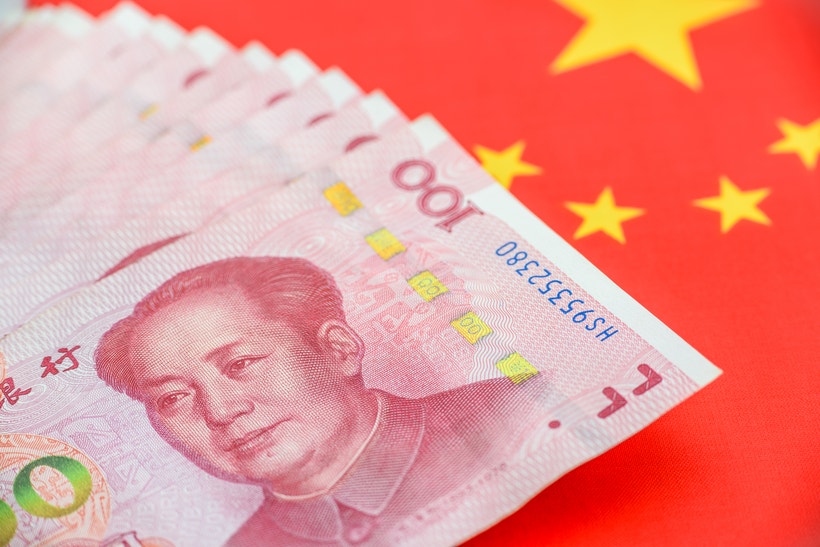Why Chinese stimulus could boost Australian dollar prices
Chinese stimulus boosts global stocks and commodity prices, propelling AUD to a 14-month high. With FXI's 40% recovery and a strong correlation to AUD, traders foresee continued AUD appreciation amid economic optimism.

Chinese stocks rally 6% on PBoC stimulus
The CN50 shot up 6% after the People’s Bank of China (PBoC) announced the largest stimulus measures since the pandemic. These plans sent world stocks soaring, particularly Asian and European shares, and led to bounces in commodity prices. These plans include reserve requirement ratio cuts, reduced key lending rates, and lower loan prime rates. The aim of these policies is to counteract economic slowdown and boost the domestic economy. The surge in the CN50 and subsequent global market reactions highlight the far-reaching impact of China's economic policies on world stocks and commodity prices, reflecting renewed optimism for economic recovery and growth.
Are Chinese equities making a comeback?
In January 2024, the Chinese large-cap stock ETF FXI traded below $21.00, marking its lowest price since the Financial Crisis of 2008. This significant decline underscored the challenges facing the Chinese stock market at the time, including economic slowdown concerns, regulatory crackdowns, and external geopolitical tensions. However, since hitting this low, the market has demonstrated a remarkable recovery, bouncing back more than 40% from its trough. FXI is now approaching the $30.00 mark for the first time in over a year, reflecting renewed investor confidence and robust market momentum. The recovery of FXI from its lows highlights the resilience of the Chinese market and the effectiveness of policy measures in driving economic recovery. Investors are now closely watching the $30.00 level as a critical resistance point, with potential implications for market sentiment and future price action. A sustained move above this level could attract further investment and signal continued strength in Chinese large-cap stocks.
AUD/USD nears multi-year high 0.6900
In related news, the Australian dollar (AUD) surged to 0.68825 this morning, marking its highest level in over 14 months. This positive trend for the aussie can be attributed to a combination of recent economic policy developments. One significant factor is the hawkish stance from the Reserve Bank of Australia (RBA), which has bolstered investor confidence in the AUD. The RBA's decision to maintain its current key interest rate and borrowing costs is aimed at steering inflation back to its 2-3% target range. In contrast, the US Federal Reserve has adopted a dovish stance, which has weakened the US dollar and made the AUD more attractive in comparison. Moreover, the Chinese government's recent stimulus measures have provided additional support for the AUD. Finally, the PBoC's significant stimulus package of reserve requirement ratio cuts, reduced key lending rates, and lower loan prime rates, aims to inject liquidity into the Chinese economy and stimulate growth. These measures are expected to boost economic activity in China, Australia's largest trading partner, and increase demand for Australian exports such as iron ore, coal, and agricultural products, thus contributing to the strength of the aussie.
AUD/USD price history

Historical correlation of Chinese stocks to Australian dollar
The Chinese large-cap stock ETF FXI and the AUD/USD currency pair currently exhibit a positive correlation of approximately +0.5, with a historical average around the same level. This positive correlation indicates that these two markets tend to move in the same direction relatively frequently. Since China is Australia's largest trading partner, economic developments in China tend to directly impact the Australian economy and, consequently, the AUD. When the Chinese economy shows signs of growth or stability, Chinese equities, represented by FXI, tend to perform well. This positive sentiment often spills over to the AUD, as stronger Chinese demand for Australian exports boosts the Australian economy. For example, if Chinese industrial production and infrastructure investment are on the rise, this increased demand for commodities benefits Australian exporters, leading to a stronger AUD. The inverse of this is true as well as it relates to weakness or volatility from either economy. In summary, the positive correlation of about +0.5 between the Chinese large-cap stock ETF FXI and AUD/USD offers valuable insights for traders, enabling them to capitalize on the interdependencies between these two major economies.
What’s next?
Given the current market dynamics, the AUD has potential for further appreciation. The PBoC's stimulus measures are expected to sustain economic activity in China, driving up demand for Australian exports. Additionally, the positive correlation between Chinese equities and the AUD suggests that continued strength in Chinese markets will further boost the Australian dollar. As the AUD approaches the 0.6900 level, traders should watch for potential upward momentum, supported by ongoing Chinese economic recovery and favorable policy stances from both the RBA and the PBoC. If these conditions persist, the AUD could see sustained gains.
How to trade AUD/USD
- Open an account to get started, or practice on a demo account
- Choose your forex trading platform
- Open, monitor, and close positions on AUD/USD pairs
Trading forex requires an account with a forex provider like tastyfx. Many traders also watch major forex pairs like EUR/USD and USD/JPY for potential opportunities based on economic events such as inflation releases or interest rate decisions. Economic events can produce more volatility for forex pairs, which can mean greater potential profits and losses as risks can increase at these times.
You can help develop your forex trading strategies using resources like tastyfx’s YouTube channel. Our curated playlists can help you stay up to date on current markets and understanding key terms. Once your strategy is developed, you can follow the above steps to opening an account and getting started trading forex.
Your profit or loss is calculated according to your full position size. Leverage will magnify both your profits and losses. It’s important to manage your risks carefully as losses can exceed your deposit. Ensure you understand the risks and benefits associated with trading leveraged products before you start trading with them. Trade using money you’re comfortable losing.
